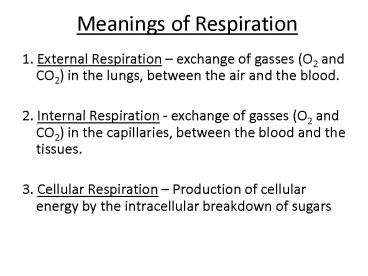Meanings of Respiration - PowerPoint PPT Presentation
1 / 17
Title:
Meanings of Respiration
Description:
Meanings of Respiration 1. External Respiration exchange of gasses (O2 and CO2) in the lungs, between the air and the blood. 2. Internal Respiration - exchange of ... – PowerPoint PPT presentation
Number of Views:37
Avg rating:3.0/5.0
Title: Meanings of Respiration
1
Meanings of Respiration
- 1. External Respiration exchange of gasses (O2
and CO2) in the lungs, between the air and the
blood. - 2. Internal Respiration - exchange of gasses (O2
and CO2) in the capillaries, between the blood
and the tissues. - 3. Cellular Respiration Production of cellular
energy by the intracellular breakdown of sugars
2
Cellular Respiration
- Energy releasing process by which glucose
molecules are chemically broken down to produce
energy in the form of ATP - ATP is used to do various types of cellular work
(active transport, synthesis, maintenance,
growth, repairing, and muscle work)
3
- Glucose C6H12O6
- 6 atoms of carbon
- 12 atoms of hydrogen
- 6 atoms of oxygen
- O2 oxygen gas
- CO2 carbon dioxide gas
- H2O water
4
- ATP adenosine triphosphate
- ADP adenosine diphosphate
- Pi phosphate
- ADP Pi ATP
energy
5
- Aerobic requiring O2
- Anaerobic not requiring O2
6
Cellular RespirationSimplified Formula
- C6H12O6 6 O2 36 ADP 36 Pi
- 6 CO2 6 H2O 36 ATP
7
The Three Stages of Cellular Respiration
- Glycolysis (does not require O2).
- The Krebs cycle (requires O2).
- Electron transport chain (ETC) (requires O2).
8
Glycolysis
- One molecule glucose is partially broken down to
2 molecules of pyruvic acid (3-carbon molecules).
- Takes place in the cytoplasm.
- Primitive and inefficient process, extracting
only about 5 of the energy in glucose. - Occurred first in evolution, because the
concentration of oxygen in the air was low.
9
- Fermentation is glycolysis without the later
steps in respiration. But in fermentation, there
is a simpler second step that does not produce
energy pyruvic acid is converted to alcohol and
carbon dioxide, acetic acid, or lactic acid.
10
Fermentation in Different Cells
- Yeast cells Glucose ? CO2 Ethanol
- Cider Bacteria Glucose ? Acetic acid
- Sauerkraut Bacteria Glucose ? Lactic acid
- Anaerobic respiration in muscle cells
- Glucose ? Lactic acid
11
The Krebs Cycle and the ETC occur inside
mitochondria
mitochondrion
12
The Electron Transport Chain 1
- The first carrier donates electrons to the next
carrier, and so on down the line. The last
electron acceptor is O2 , and H2O is formed. - The electron movement provides energy to move
hydrogen ions, pushing them into the outer
compartment of the mitochondria.
13
The Electron Transport Chain 2
- Hydrogen ions flow back into the inner
compartment through an enzyme called ATP
synthase. This flow causes ATP synthase to
rotate, which puts Pi onto ADP, thus making ATP.
14
The Electron Transport Chain
Hydrogen flows back to inner compartment,
generating ATP
As electrons are transported, hydrogen is pumped
from the inner compartment to the outer
15
ATP production from Cellular Respiration
- Glycolysis 2 ATP
- Krebs cycle 2 ATP
- ETC 32 ATP
- _____________________
- Total 36 ATP per molecule of glucose
16
External Respiration (Respiratory Systems)
- Large aerobic organisms need to take in oxygen
and get rid of CO2. Various respiratory systems
developed in different animals, depending on
their environment and their life style.
17
Respiratory Structures
- Lungs - in all vertebrates except fish
- Gills - in fish
- Skin gills - surrounded by pincers -
Echinoderms/Starfish - Book gills - between belly plates - some
Arthropods/Horseshoe crab - Tracheae and spiracles insects (air tubes that
branch internally)































